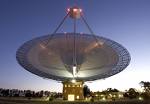 |
Science with Parkes WorkshopTalk Abstracts |
 |
Matthew Bailes
A new high resolution pulsar survey with the Parkes multibeam receiver.
Digital filterbanks are becoming commonplace in modern astronomy, and ten years after the first Parkes multibeam survey a team from the ATNF, Swinburne, Manchester and Cagliari are planning an ambitious new pulsar survey that will have ten times the frequency resolution of previous surveys. This survey will largely eliminate the dispersive effects of the interstellar medium on millisecond pulsars out to distances of several kpc, and make double pulsars observable out to the scattering limit. I will review the prospects for such a survey and discuss how the hardware planned can largely eliminate the need for almost all existing backends at the telescope reducing maintenance issues and making the telescope more efficient.
Kate Brooks
And then there were seven - the new 22GHz system for Parkes
The new 22 GHz system that will be delivered to Parkes in early 2008 completes the suite of new receiver systems built for the Australia Telescope under an award from the Major National Research Facilities (MNRF) Program. In my talk I will present the observing specifications of the new Parkes 22 GHz system and discuss how they compliment the 22GHz systems on Mopra and the Australia Telescope Compact Array. I will also revisit the science case for a 22GHz multibeam on Parkes in the light of future 22 GHz instrumentation planned for the GBT.
Robert Braun
Diffuse Neutral Hydrogen in the Local Universe
Multiple independent lines of evidence demonstrate that the surface area subtended by atomic hydrogen at column densities near 1017 cm-2 exceeds that seen at 1019 cm-2 by about a factor of 30. Intervening column densities are rarely encountered because of ionization in the intergalactic radiation field. Although at the limits of current technology to detect, deep integrations with the Parkes Multi-Beam system can reach the required sensitivity to image such gas in the local universe. This HI "Cosmic Web" is likely to be in the form of filaments and other diffuse structures in the vicinity of massive galaxies, although only a single confirmed example has been imaged to date. In view of the long dynamical timescales, these features retain essentially a Hubble-time's worth of interaction and feed-back history. Once such structures are found, then optical and UV absorption measurements toward background AGN can constrain the ionization state and metallicity. The expectation is that this phase contains a similar baryon mass in hydrogen to the total baryon mass accounted for by galaxies in both gas and stars!
Michael Burton
Parkes in the 12mm Band
12mm is ALMA's Band 0 - the missing piece from the jigsaw that ALMA is going to fill in for the millimetre-wave Universe. It is also a band in transition, from molecular cloud astrophysics to the physics of the ionized medium. Ammonia is the great molecule in this band, the best probe of the dense molecular medium, unlike CO which traces the diffuse regions of molecular clouds. Measurement of the various rotational lines in the 12mm band also provides an immediate measure of the density and temperature of the emitting gas, parameters which are much harder to determine using CO lines. Ammonia emission is, in general, extended, which greatly complicates the interpretation of emission maps made by an interferometer like ATCA. Parkes will also have better than twice the resolution of Mopra at 12mm, and six times the collecting area. Parkes is thus well suited for sharper, sensitive imaging of ammonia clouds mapped by Mopra through the HOPS survey. Parkes will be able to zoom into the Mopra ammonia maps in a similar manner to the way Mopra is zooming into the NANTEN CO maps of the galactic plane.
Ammonia mapping at Parkes may also be used to investigate the most energetic phenomena in astrophysics, gamma-rays induced by ultra-high energy cosmic rays, which use dense molecular cores as their targets to produce the particle collisions. It is actually unclear whether cosmic ray diffusion will limit the penetration of medium-energy cosmic rays into cloud cores, to be targeted by the GLAST mission. By contributing to the determination of the density structure of molecular clouds, in particular the relative proportions of low density (i.e. CO) and high density (i.e. NH3) gas, which is partially responsible for the observed gamma ray spectrum, Parkes might contributing to the understanding of the physics behind cosmic ray acceleration to the highest energies.
The 12mm band also hosts a plethora of molecular lines, particularly from long carbon-chain molecules with large dipole moments. Sensitivity is needed to probe the amazing astrochemistry underway, as the lines are weak and the molecules rare. Limited work has been done in this regime as a result, using giant telescopes like the Nobeyama 45m and the Greenbank 100m. Parkes can contribute much to this field, in particular because the most interesting galactic sources for such studies all lie in the South.
Mapping investigations at 12mm would be facilitated by the use of a multibeam receiver array, as they also would at 3mm with Mopra. A Mopra-style wide-band, high-spectral resolution correlator would allow the simultaneous measurement of the ammonia rotational lines, and so to mapping the density and temperature structure of cloud cores. It would also greatly enhance the study of carbon-chain chemistry, as it is essential to measure many lines to provide a handle to understand what species are present, and what chemistry is actually taking place.
Sarah Burke
Unique Scientific Prospects in Pulsar Astronomy with the Parkes Telescope
This talk will review new (current and future) projects related to pulsar timing and searching with the Parkes Radio Telescope, detailing the potential and expected science returns from the upcoming high resolution Multibeam Pulsar and Transients Survey and from pulsar timing's focus on searches for gravitational waves. The talk will discuss the involvement of Parkes and why it is unique in its ability to carry these projects to completion and deliver key scientific results in the coming years.
David Champion
Pulse@Parkes
Pulse@Parkes is an outreach project aimed, initially, for high schools in the Greater Sydney area. The project will later be extended both nationally and internationally. Classes will visit the Marsfield site and control the Parkes telescope remotely to observe pulsars. The data taken will form the basis of projects to be completed on the day and later back at the school. Observations will be made for the GLAST mission, the pulsar timing array project and for studies of rotational irregularities in young pulsars. The project will demonstrate the ability to control Parkes remotely and provide a basis for future outreach work with ASKAP.
Simon Ellingsen
Future Maser Studies with Parkes
Observations made with the Parkes telescope have formed the foundation of many of the seminal southern hemisphere maser studies and this continues to the present day. The current methanol multibeam survey is providing an unprecedented insight into the location and frequency of high-mass star formation within our Galaxy. With recent advances in the sensitivity and resolution of observations in the millimetre through mid-infrared regimes, maser observations are playing an increasingly important role in the field of star formation and this is likely to expand further in the ALMA era. As masers are intrinsically narrow-band objects, there is no substitute for a large aperture telescope when sensitive observations are required and so Parkes has a unique and pivotal role in the southern skies. I will outline a number of high-impact maser projects (covering star formation, late-type stars and AGN) which could be undertaken with Parkes over the next 5-10 years.
Marijke Haverkorn
Polarized continuum with Parkes
Large single dishes like Parkes play a major role in studies of large-scale diffuse radio emission with a wide variety of scientific goals. Full sampling of spatial scales is imperative for observing diffuse synchrotron emission, cosmic magnetic fields and extended objects like HII regions and old and/or nearby supernova remnants. The newly developed technique of rotation measure synthesis can construct a tomographic view of the magnetized medium in the ISM and in these objects, but only if all spatial scales are included, especially in low-emission regions. This makes Parkes the prime instrument for this kind of research in the Southern hemisphere. I will discuss these and other scientific applications of radio polarimetric surveys and will introduce S-PASS, the S-band Parkes All-Sky Survey, a recently started 2.3 GHz polarimetric survey. S-PASS combines exploration of Galactic turbulence, extended objects and interstellar magnetism with the characterization of the Galactic foreground for CMB polarization studies.
George Hobbs
Pulsar Timing at Parkes
I will first describe the scientific impact of recent and current pulsar timing projects at Parkes. I will highlight the reasons why the Parkes observatory is World-leading in high-precision pulsar timing. My talk will conclude with possible projects in the next 5-10 years and emphasise that ASKAP will not be competitive with Parkes for high precision pulsar timing on this time scale.
Emil Lenc
Parkes, ASKAP and VLBI in the 21st Century
As part of the Long Baseline Array (LBA), the Parkes radio telescope has played a critical role in southern hemisphere Very Long Baseline Interferometry (VLBI) observations. Recent upgrades at Parkes and the LBA have opened up new opportunities for science. I will discuss the importance of Parkes as an element of the LBA, the VLBI science that it enables and the future possibilities once ASKAP is operational.
John Reynolds
Future Instrumentation at Parkes
The state of current instrumentation is summarised and future directions for the next 2-5 years described.
Patrick Weltevrede
Pulsar timing at Parkes of (almost) known gamma-ray pulsars
We currently only know of about 7 pulsars which have gamma-ray counterparts, hence our understanding of the gamma-ray emission of rotation powered pulsars is extremely limited. This will change over the coming years because of the new gamma-ray satellites AGILE, and especially GLAST, which will discover many more gamma-ray pulsars. However, the gamma-ray counterparts can only be found when Parkes continues monitoring these (almost) known gamma-ray pulsars during these space missions.
Organising Committees
- Scientific Organisers
-
- Simon Johnston(Simon.Johnston AT csiro.au)
- Naomi McClure-Griffiths (Naomi.McClure-Griffiths AT csiro.au)
- Local Organiser
-
- Michael Dahlem (ATNF)
